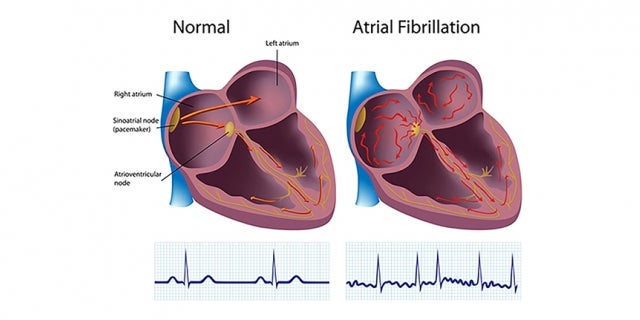Have you felt a strange sensation in your chest but didn’t know what to think? Did your heart race and then slow with deliberate beats? Have you bent over to pick something up and felt like your heart is skipping a few beats?
You could be experiencing atrial fibrillation, the most common heart rhythm disorder. Atrial Fibrillation, or AFib as it commonly referred to, occurs when the heart's two upper chambers (the atria) beat irregularly and out of coordination with the two lower chambers (the ventricles) of the heart. Symptoms include heart palpitations, shortness of breath, and weakness as a result of poor blood supply and flow throughout the body.
Oklahoma Heart Institute Cardiac Electrophysiologist, Dr. David Sandler explains the prevalence, “Atrial fibrillation is by far the most common sustained rhythm disturbance in the world, affecting up to 5 million Americans and growing!” Dr. Sandler explains why more Americans are affected by AFib, “The incidence is rising for a variety of reasons including the aging population, the obesity epidemic and increased awareness.” While the number of Americans living with AFib continues to grow, it is estimated half of the people who have AFib do not even realize they do.
From New York City Rhythm to Off Rhythm
Barry Manilow was one of those people in the late 1990s. What he thought was a demanding schedule taking a toll on his body, was actually AFib. Manilow admits he ignored the strange fluttering heart beats initially, until he was rushed to the hospital in 2004, where he was diagnosed with AFib. For Manilow, controlling his AFib has been an ongoing process, with AFib episodes occurring during media events, tours, and even nearly forcing him to cancel a national television appearance during a 4th of July celebration. Prior to his initial diagnosis, Manilow says he didn’t know anything about the rhythm disorder or that he would be affected by it.
Not Life-Threatening, But Not to Be Ignored
Ignoring AFib can be very costly. AFib can cause blood to pool, leading to clotting, which is why AFib is a leading cause of stroke. In fact, Afib increases the risk for stroke by 4 to 6 times. AFib can also have lasting damage on the heart. The longer the heart is out of rhythm, the greater potential the shape will change, causing it to work harder and potentially leading to congestive heart failure. Episodes of AFib can come and go and vary in severity. However, some people have AFib, yet experience little or no symptoms.
Back to Normal - Treatment for AFib
The initial strategy of atrial fibrillation management includes identifying possible reversible risk factors. These include valvular heart disease, an overactive thyroid gland and sleep apnea. Once reversible risk factors have been identified, a variety of treatment options are available today, including medication, minimally invasive procedures, as well as surgery. Oklahoma Heart Institute Cardiac Electrophysiologist, Dr. Craig Cameron explains ways to manage AFib and return to normal rhythm, “Treatments usually begin with medications directed at controlling the heart rhythm and preventing stroke. Procedures may also be warranted, including electrical cardioversion, catheter ablation and left atrial appendage closure.” Oklahoma Heart Institute’s Electrophysiology Team may also work together with cardiac surgeons to treat AFib as Dr. Cameron explains, “Additional therapies are coordinated with our cardiac surgical team, including minimally invasive maze surgery and left atrial appendage excision.”
A Simple Pulse Check Could Reveal AFib
With nearly 5 million Americans living with AFib, half of whom may not even know they have the arrhythmia, everyone should be checked. A simple pulse check twice a year is the first line of defense for detecting AFib. A normal pulse rate is between 60 to 100 beats per minute and is strong and regular. If your pulse is irregular or if it is too fast or too slow, notify your physician. With more Americans aware the potentially life-threatening link between AFib and stroke, detection and treatment could significantly reduce the 80,000 AFib related stroke deaths each year.

